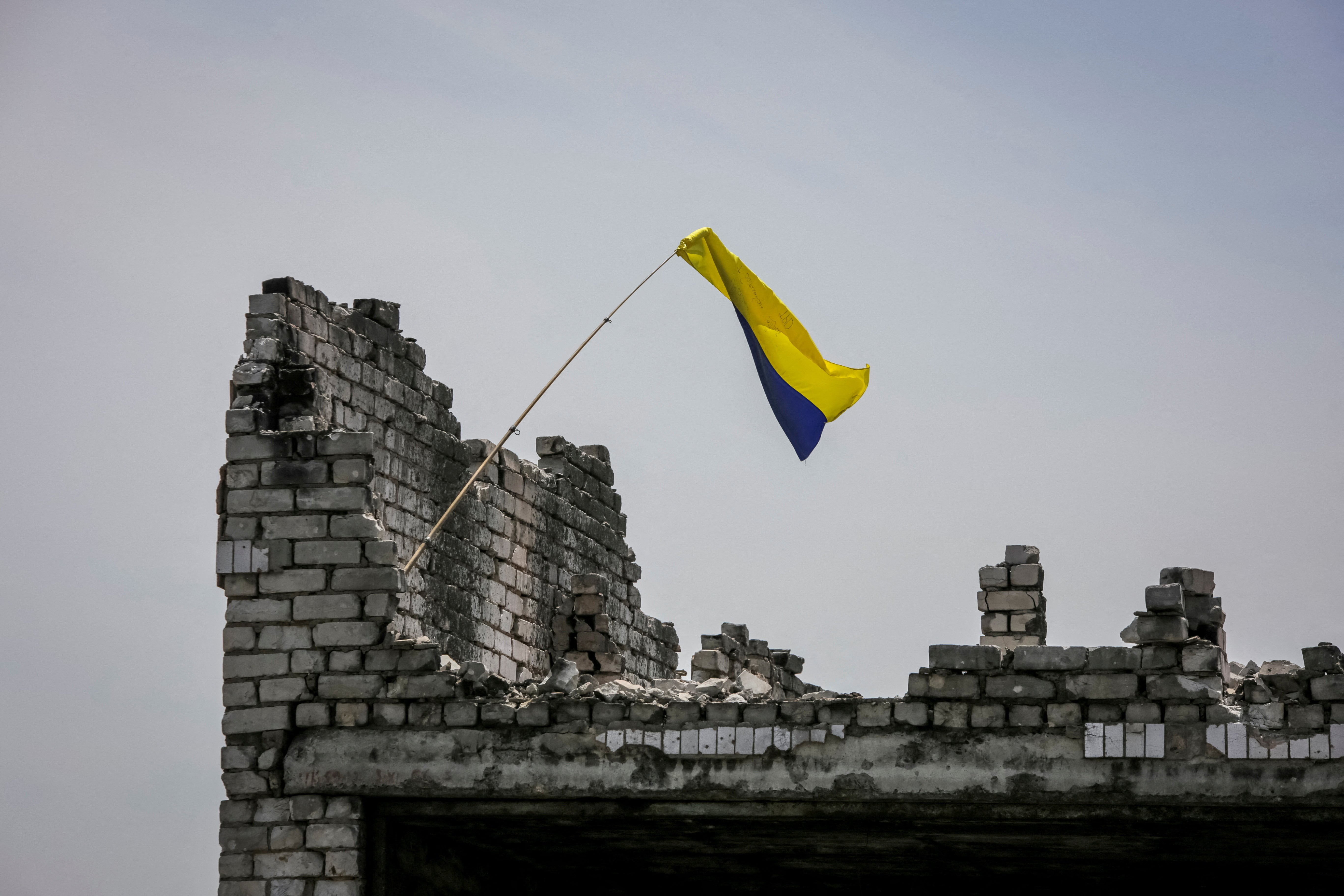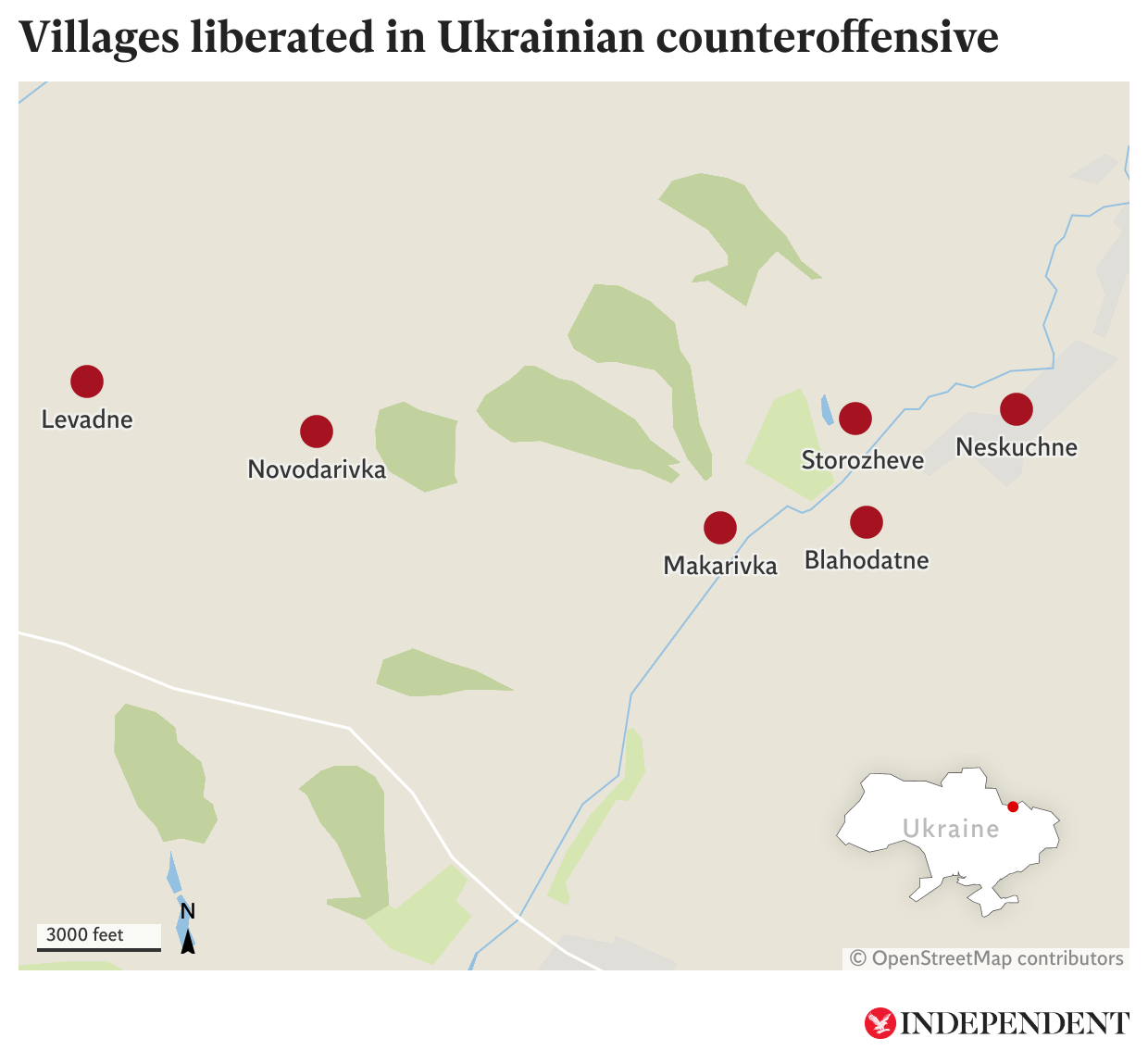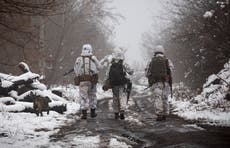How significant are the reported territorial advances made by Ukrainian forces so far?
Resistance appears to have won back a number of villages and made progress to the east and south in the opening skirmishes of its long-trailed counteroffensive
Your support helps us to tell the story
From reproductive rights to climate change to Big Tech, The Independent is on the ground when the story is developing. Whether it's investigating the financials of Elon Musk's pro-Trump PAC or producing our latest documentary, 'The A Word', which shines a light on the American women fighting for reproductive rights, we know how important it is to parse out the facts from the messaging.
At such a critical moment in US history, we need reporters on the ground. Your donation allows us to keep sending journalists to speak to both sides of the story.
The Independent is trusted by Americans across the entire political spectrum. And unlike many other quality news outlets, we choose not to lock Americans out of our reporting and analysis with paywalls. We believe quality journalism should be available to everyone, paid for by those who can afford it.
Your support makes all the difference.Ukraine has reported regaining further ground from invading Russian forces along the eastern and southern fronts in July as its counteroffensive continues, following on from the liberation of a number of frontline villages in June.
Speaking during his latest nightly address on Thursday 27 July, Ukrainian president Volodymyr Zelensky claimed the recapture of another village, declaring: “I thank everyone who is fighting for Ukraine! Thank you for the liberation of Staromaiorske. Congratulations again, guys!”
That came after even his Russian counterpart Vladimir Putin was forced to admit the Ukrainians were making advances and that the fighting had escalated in recent days.
Hosting a summit of African leaders in St Petersburg, Mr Putin admitted that attacks on his troops by Kyiv’s forces had “intensified significantly”, primarily in the Zaporizhzhya region.
Earlier in July, the Ukrainian military said its troops have so far retaken more than 65 square miles on the southern front and 9.26 square miles around the eastern city of Bakhmut since the counteroffensive effort commenced.
Deputy defence minister, Hanna Maliar, writing on the Telegram messaging app, said that heavy fighting raged in two areas of the southeast and that Ukraine was “consolidating” its gains in those regions.
Ukrainian military analyst Denys Popovych meanwhile reported that Ukrainian forces had taken “important positions near Klishchiivka”, a village lying on heights to the south of Bakhmut.
For its part, Russia’s Defence Ministry said brutal fighting had persisted in that area, with combat made difficult “not only by the daily intensity of fire and battle, but also by topography. The line of contact runs between two hills.”
Pro-Moscow Chechen leader Ramzan Kadyrov also took to Telegram to claim that his “Akhmat” unit had been deployed to the region.
At the start of this month, Ukraine said its soldiers had made steady advances in the Lyman, Avdiivka and Mariinka directions of Donetsk in the Donbas as Russia’s under-pressure defence minister Sergei Shoigu moved to deny that the short-lived rebellion by the Wagner Group, which saw them occupy Rostov-on-Don and march on Moscow in protest on 24 June, had had any impact on its operations in Ukraine.
After months of speculation about when the Ukrainian counteroffensive might begin, unverified photographs and video began to appear on social media on 11 June showing its soldiers holding aloft their country’s blue and yellow flag in triumph above the eastern villages of Storozheve, Blahodatne, Neskuchne and Makarivka in Donetsk, suggesting they had been recaptured from occupying enemy troops.

Ms Maliar posted one such photo from Storozheve and thanked the 35th Separate Brigade of Marines for liberating it and subsequently reported that Ukraine had won back three more villages in Zaporizhzhia – Lobkove, Levadne and Novodarivk – and made fresh advances near Bakhmut, on the Toretsk front in the east and towards the port city of Berdyansk.
“The enemy is doing everything to hold on to the positions it has seized,” Ms Maliar wrote on Telegram two days later.
She added that Russian forces had air support and were showering Ukrainian troops with intense artillery fire and that the latter were encountering “continuous minefields which are combined with anti-tank ditches.”
“All this is combined with constant counterattacks by enemy units on armoured vehicles and the massive use of ATGMs [anti-tank guided missiles] and kamikaze drones,” Ms Mailer reported.
A team of Reuters journalists subsequently visited Neskuchne, observing that no building had been left unscarred by the fighting, noting three Russian corpses lying in the road and writing: “The hamlet was silent except for birdsong and the crump of artillery fire in the distance.”
Since then, at least three more villages have been added to the list, bringing the reported total to 10.
Kyiv has imposed a strict silence on its armed forces to avoid compromising an operation it hopes will retake swathes of land and eventually threaten the land bridge Russia has established for use in supplying the occupied Crimea.
In practical terms, the advance represented by the retaking of the villages amounts to only modest gains: Makarivka, for instance, is around three miles short of the frontline and 56 miles from the southern rim of the aforementioned bridge over the Sea of Azov.
But the symbolic value of Ukraine’s most rapid progression forward for seven months, after an arduous winter, is obvious, a timely boost to national morale for a beleaguered nation still reeling from the collapse of the Nova Kakhovka Dam, allegedly brought down after being mined by Russian soldiers, flooding neighbouring towns for miles around and leaving the region’s farmland swamped, its crops ruined and livestock drowned.
As the pushback continues, Ukraine is banking on the huge amount of weaponry, training and intelligence it has received from the West, combined with its own battlefield resolve, tactical nous and the motivation of driving an invader from its own land, to give it the edge in the conflict.
The country also knows it may have to show significant progress over the summer to ensure its international allies demonstrate the same level of commitment in future.
But so far the response has been positive, with Nato secretary-general Jens Stoltenberg telling US president Joe Biden recently: “The Ukrainians are making progress, making advances. It’s still early days, but what we do know is that the more land that Ukrainians are able to liberate, the stronger hand they will have at the negotiating table.”
The US has responded by announcing that it will begin supplying Ukraine with cluster bombs for “very careful” use on its own territory against Russian forces, despite previously criticising Russia’s use of such munitions and the opposition of other nations, 100 of whom signed a 2008 treaty in Oslo, Norway, objecting to their deployment in warzones.
Moscow has largely refrained from officially acknowledging any Ukrainian advances, insisting that it has consistently repelled attacks and inflicted heavy casualties on opposition forces.

Unverified footage circulated on social media by pro-Russia accounts has meanwhile shown destroyed American and German armoured vehicles, clearly intended to undermine allied faith in the Ukrainian cause.
It is unquestionably too early to draw conclusions about the fate of the counteroffensive from these early skirmishes, which may be more about testing Russian defences than staking out major land gains.
The US-based Institute for the Study of War said Ukraine was attempting “an extraordinarily difficult tactical operation, a frontal assault against prepared defensive positions, further complicated by a lack of air superiority and these initial assaults should not be extrapolated to predict all Ukrainian operations”.
Ben Hodges, a former commander of US forces in Europe, told the Center for European Policy Analysis that the main attack, when it came, would be expected to feature several hundred tanks and infantry fighting vehicles.
“The offensive has clearly started, but not I think the main attack,” he said.
“When we see large, armoured formations join the assault, then I think we’ll know the main attack has really begun.”
That tallies with Ms Mailar’s recent comments on domestic television, when she told the nation the “main events” of the attack remain “ahead of us”, adding: “The main blow is still to come.”
Oleksandr Syrskyi, the commander of Ukraine’s ground forces, similarly told The Guardian: “I want to say that our main force has not been engaged in fighting yet, and we are now searching, probing for weak places in the enemy defences. Everything is still ahead.”
Additional reporting by agencies




Join our commenting forum
Join thought-provoking conversations, follow other Independent readers and see their replies
Comments